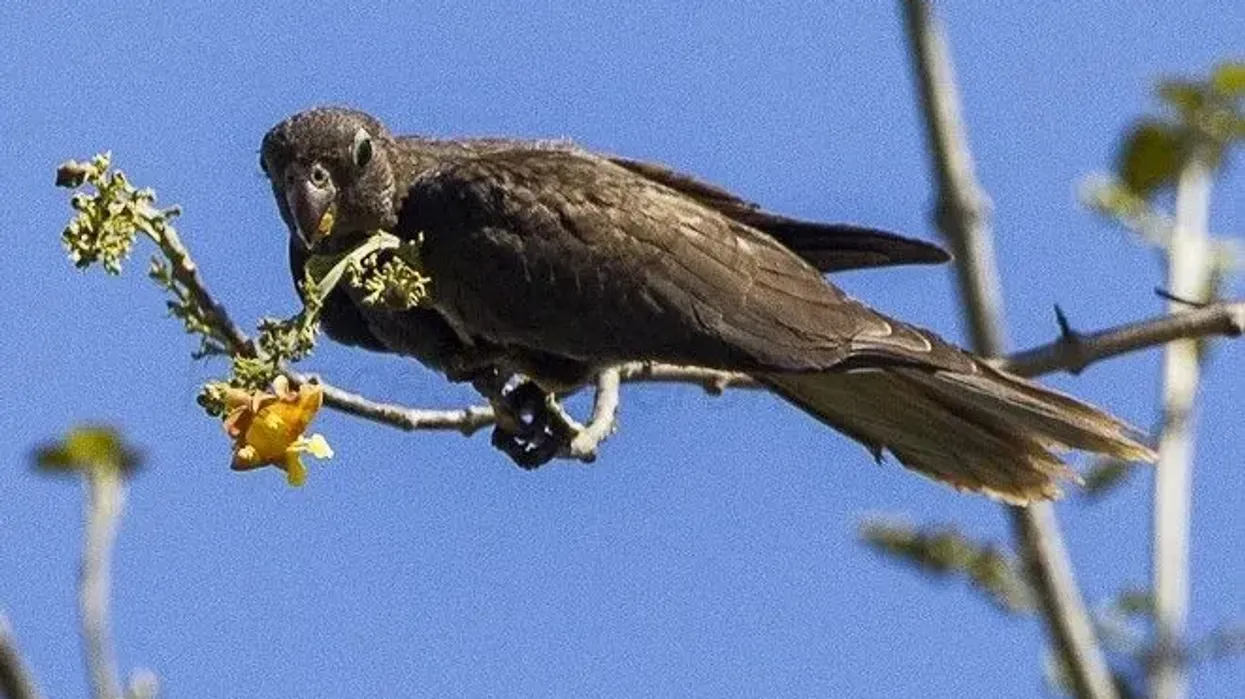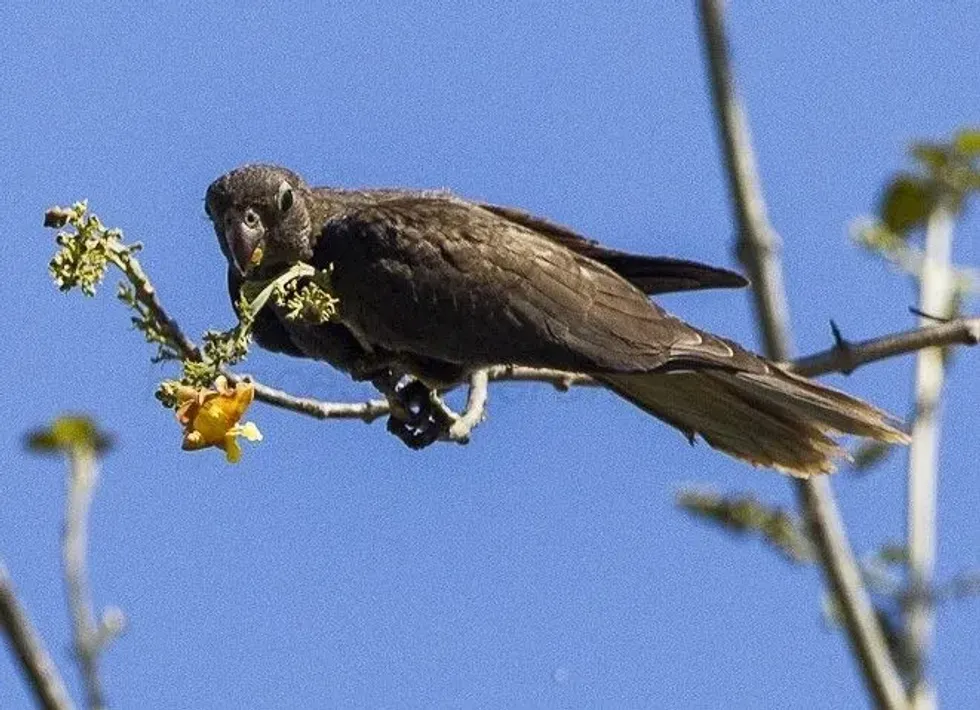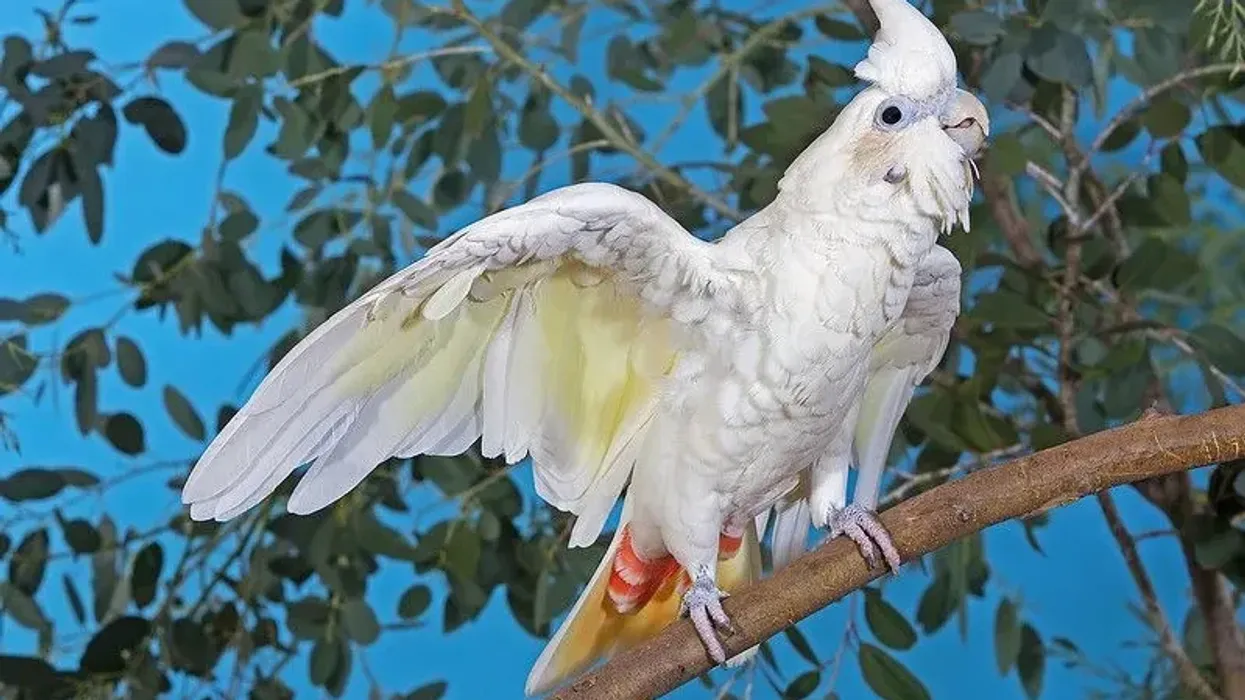Take a walk in the evergreen forests of Madagascar and you are sure to come across the magnificent lesser vasa parrot (Coracopsis nigra). This parrot is an endemic resident of the biologically diverse swamps and forests of Madagascar and the Seychelles islands.
This gray parrot will steal your precious objects as well as your heart with its inquisitive, mischievous personality and affectionate behavior.
The lesser vasa parrot (Coracopsis nigra) is one of four species of vasa parrot found in the islands of Madagascar and the Seychelles and is a gray, medium-sized bird.
It makes its nests in its natural habitat of humid, evergreen forests and mangrove swamps, and can be found in homes all over the world as well. It is a popular pet, known for its fun-loving nature and talking and mimicking ability, proving to be quite an entertaining bird.
It is affectionate, cozying up to everyone, and can make a great companion for any bird lover!
To learn more about these mischievous parrots, read on! For more relatable content, check out these Senegal parrot facts and toco toucan facts for kids.
Lesser Vasa Parrot Interesting Facts
What type of animal is a lesser vasa parrot?
The lesser vasa parrot (Coracopsis nigra) is one of two species of vasa parrot and is a type of bird. The other species of vasa parrots is the greater vasa parrot (Coracopsis vasa), which is larger in size than the lesser vasa parrot.
What class of animal does a lesser vasa parrot belong to?
The lesser vasa parrot belongs to the class of Aves of Animalia kingdom.
How many lesser vasa parrots are there in the world?
The current population size of this vasa parrot species is unknown, though they are known to be quite commonly spotted in their native habitat.
Where does a lesser vasa parrot live?
The lesser vasa parrot species can be found exclusively on the island nation of Madagascar in the wild, as it is endemic to that region.
What is a lesser vasa parrot's habitat?
The lesser vasa parrot can be found living mostly in evergreen forests and mangrove swamps, spread across the islands of Madagascar and the Seychelles.
Who do lesser vasa parrots live with?
Lesser vasa parrots can usually be found in small flocks during the day, moving about the forest together. During the breeding season, they can be found in groups of male and female vasa birds nesting together. These birds tend to have multiple breeding partners during a single season.
How long does a lesser vasa parrot live?
Lesser vasa parrots have been observed to live for as long as 30 years of age.
How do they reproduce?
Unlike other parrots, the lesser vasa parrot is not monogamous in nature. Females have been observed to have multiple partners in one season.
The breeding season for these parrots usually occurs between October and January. They have a unique territorial battle between formed pairs that will determine the alpha pair, meaning the pair that gets to mate first. After mating, the female vasa will lay around two to five eggs which she will incubate herself for around 14-17 days.
Though both sexes of this species obtain yellow head feathers during the breeding season, the yellow head of the female vasa parrot is more striking and noticeable due to the actual skin turning yellow as well. Due to the absence of any feathers due to molting, their yellow heads are more prominent than their male counterparts.
What is their conservation status?
As of now, the conservation status for these parrots is of Least Concern. As they are quite abundant in their habitat, it can be concluded that they are not endangered at the moment.
Lesser Vasa Parrot Fun Facts
What do lesser vasa parrots look like?
The lesser vasa parrot is a gray, long-necked bird with both sexes looking quite similar. They have smoky gray feathers all over their body, including their long tail feathers.
During the breeding season, their faces and heads tend to turn yellow in color. However, female vasa parrots undergo a dramatic change in which the feathers on their whole body turn light brown and the feathers on their head fall off, rendering them bald! The beaks of both sexes also lighten during the mating period, turning almost completely white.
How cute are they?
With their adorable eyes and fun personalities, these birds have a very cute demeanor. They are very entertaining and affectionate, and always ready for a cuddle.
How do they communicate?
These birds have naturally shrill voices and have a whine-like call which differentiates them from the greater vasa. Though they are considered to be quieter than other parrot species, they become noticeably louder during the mating season with their shrill calls echoing all over the forest.
How big is a lesser vasa parrot?
The lesser vasa parrot is a medium-sized bird, much smaller than the greater vasa parrot. The lesser vasa measures 13 in (33 cm) from beak to tail on average. It is the same size as the African gray parrot, being quite similar in appearance as well and a bit smaller than thick-billed parrots.
How fast can a lesser vasa parrot move?
Though greater vasa black parrot (Coracopsis vasa) birds can often be seen flying in the wild, their exact speed of flight is unknown as of now. Lesser vasa parrots are non-migratory birds and there are no reports on how fast these birds can fly over long distances. In general, vasa parrots can fly 30 mi (48 km) per day.
How much does a lesser vasa parrot weigh?
On average, lesser vasa parrot birds are known to weigh around 6.7 oz (190 g). They are much lighter in weight than kea parrots.
What are the male and female names of the species?
There are no specific names for either sex of this species. Male vasa birds are called cocks and females are called hens.
What would you call a baby lesser vasa parrot?
Baby vasas are known as chicks or hatchlings.
What do they eat?
Lesser vasa parrot nutrition depends on their vegetarian diet, consisting of fruits, seeds, and flower blossoms in the wild. They are also very fond of berries and when kept as pets, they can be fed a wide range of fruits, vegetables, and grains.
A limit should be kept on how much food this bird gets as it loves to eat and can overeat itself into obesity if given too much to eat.
Are they dangerous?
No, vasas are not dangerous at all, rather the opposite. Their personalities are quite friendly and cheerful! Female vasa parrots are known to become slightly moody and aggressive during the breeding period.
Would they make a good pet?
Lesser vasas are intelligent, charming birds that make great pets. They are known to be quite intelligent and love to play with toys and puzzles which keep them engaged.
They are fun birds to have around, being friendly and affectionate with almost everyone they meet.
They love spending time outside their cages, playing around with people, and being mischievous.
They are very nosy and entertain themselves by ripping papers, moving around small objects, and pecking at things, so it's best to keep important papers and precious items out of this bird's sight!
They are very active in nature, so it is best to keep them in large aviaries where they can fly about during the day as well as let them out of the cage to spread their wings.
There are a few diseases and common health problems that need to be looked out for while keeping these birds as pets. Though they are normally healthy birds, they may contract psittacine beak and feather disease, which affects many species of parrots.
They may also suffer from avian flu or egg binding. If these health problems are caught early, they can be kept in check and your pet's life can be considerably prolonged.
Please check local laws and regulations as rules may vary from country to country and state to state about keeping these animals as pets.
Did you know...
Coracopsis vasa birds love to bathe, and can often be seen sunning themselves or rolling around in the mud. They are very fond of water baths as well and love to clean themselves on a regular basis.
Lesser black parrot vasas have the shortest incubation period of any parrot, being between only 14-17 days.
Females tend to be more dominating and can be seen acting aggressively towards the male birds during the breeding period.
Though the C. vasa parrot is gray in color, it is also known as the black parrot.
It is one of two species of vasa parrot, the other being the greater vasa parrot. The Seychelles black parrot is also considered a species of vasa parrot, but sometimes it is considered as its own species. The Seychelles black parrot is also the national bird of the Seychelles islands.
During the breeding season, they can be observed chewing on wood and chalk because they become a bit aggressive during this time. Despite being curious, they are not destructive, merely trying to explore their surroundings and entertain themselves.
Can lesser vasa parrots talk?
Lesser vasas are known to be one of the best talkers among bird species and are known to be quite the chatterboxes. Along with their fun-loving personality, they love to repeat words and phrases and are skilled mimics.
Their favorite sounds to imitate are alarms, barks, and phones. They also love singing, being able to sing complicated melodies off the top of their heads.
How much does a lesser vasa parrot cost?
Vasa parrots, being an exotic species of bird, can be quite expensive if considering one as a pet. Buying one of these lively birds will set you back around $1500-$1600. These parrots can be obtained from pet stores or by contacting certified breeders.
Here at Kidadl, we have carefully created lots of interesting family-friendly animal facts for everyone to discover! Learn more about some other birds from our toucan interesting facts and common nighthawk fun facts pages.
You can even occupy yourself at home by coloring in one of our free printable Australian king parrot coloring pages.









